Chandra events¶
Overview¶
The kadi Chandra events database stores a variety of events that are useful in performing analysis or establishing situational awareness (i.e. what was happening around March 2017?). Examples include:
Events in telemetry such as maneuvers, NPM dwells, obsids, mech movements, momentum dumps, orbit events, etc.
CAPs, DSN passes, dark cals, SCS107, safe modes, bright star hold, etc
Chandra major events since launch
As shown in the Event definitions section, there are a number of different types of Chandra events that are available within the Kadi archive. Each type of event is essentially a database table with a number of data fields, some of them common to all event types and some of them unique.
Interval events¶
Most of the event types represent an interval of time with some defining characteristic,
for instance maneuvers (Manvr), radiation zones (RadZone) or SIM TSC translations
(TscMove). The documentation for each event type contains the event defintion, for
example the Eclipse event is the interval where AOECLIPS = 'ECL'.
These “interval” event types all share the following fields:
Field name |
Description |
|---|---|
|
Start date (YYYY:DOY:HH:MM:SS.sss) |
|
Stop date (YYYY:DOY:HH:MM:SS.sss) |
|
Start time (CXC seconds) |
|
Stop time (CXC seconds) |
|
Duration (seconds) |
Many of the event types have additional fields that are specific to that type. For
example the FaMove event also provides the values of the FA step position
3FAPOS before and after the SIM focus assembly translation, and the DsnComm event
provides a host of information about each comm pass:
Field |
Type |
Description |
|---|---|---|
ifot_id |
Integer |
|
start |
Char(21) |
|
stop |
Char(21) |
|
tstart |
Float |
Start time (CXC secs) |
tstop |
Float |
Stop time (CXC secs) |
dur |
Float |
Duration (secs) |
bot |
Char(4) |
Beginning of track |
eot |
Char(4) |
End of track |
activity |
Char(30) |
Activity description |
config |
Char(10) |
Configuration |
data_rate |
Char(9) |
Data rate |
site |
Char(12) |
DSN site |
soe |
Char(4) |
DSN Sequence Of Events |
station |
Char(6) |
DSN station |
Non-interval events¶
The event types MajorEvent, ManvrSeq, and OrbitPoint are a bit different in that
they refer to moment in time rather than an interval. For these types the only field
they all have in common is date. For example the MajorEvent type has the following fields:
Field |
Type |
Description |
|---|---|---|
key |
Char(24) |
Unique key for this event |
start |
Char(8) |
Event time to the nearest day (YYYY:DOY) |
date |
Char(11) |
Event time to the nearest day (YYYY-Mon-DD) |
tstart |
Float |
Event time to the nearest day (CXC sec) |
descr |
Text |
Event description |
note |
Text |
Note (comments or CAP # or FSW PR #) |
source |
Char(3) |
Event source (FDB or FOT) |
Even though many Chandra Major Events (such as a safe mode) are really intervals in time,
the source databases do not encapsulate that information so the derived Kadi database is
likewise ignorant of the actual interval. For the specific case of safe mode events the
appropriate event type is actually SafeSun, which does have a meaningful start and
stop time.
Getting started¶
To start using the Kadi archive you first need to fire up IPython in the Ska environment. From a shell terminal window do:
% ska3
% ipython --matplotlib
Now enter the following statement. This imports the interface modules for the event and commands databases:
>>> from kadi import events
Note
The % is the standard indication for entering a command on the csh terminal
window prompt. The >>> is the standard indication of entering a command at the
Python or IPython interactive prompt. You do not actually type these characters
(although it is actually allowed to copy the >>> in IPython).
Get events as a table¶
The most basic operation is to get some events from the Kadi archive. So let’s find all the SIM TSC moves since 2012:001:
>>> tsc_moves = events.tsc_moves.filter(start='2012:001').table
Let’s break this statement down to understand what is happening. Remember that in Python
everything is an object and you can access object attributes or methods by chaining them
together with the . (period).
The first bit is events.tsc_moves, which accesses
the object that allows querying the database of TSC move events. You can easily see
all the available event types for query by doing:
>>> events.<TAB> # type "events." and then press <TAB>
events.caps events.EventQuery events.manvr_templates events.rad_zones
events.dsn_comms events.fa_moves events.models events.safe_suns
events.dumps events.get_dates_vals events.obsids events.scs107s
events.dwells events.major_events events.orbits events.tsc_moves
events.eclipses events.manvrs events.query
From events.tsc_moves we chain the filter(start='2012:001') method to select events that
occurred after 2012:001. The filter() method is very powerful and can perform
complex filters based on all the available attributes of an event. In this case to select
an inclusive time range you would supply both the start and stop date in that order,
e.g. filter(start='2012:001', stop='2013:001').
The last bit of the chain is the .table attribute, which says to convert the
filter(start='2012:001') output from a QuerySet object (which is discussed later) into a an
astropy Table that can be printed,
plotted, and used in computations. Now let’s look at what came out by printing the Table.
Before you do this make your terminal window plenty wide, there are a bunch of fields and
you want to see them all:
>>> print tsc_moves
start stop tstart tstop dur start_3tscpos stop_3tscpos start_det stop_det max_pwm
--------------------- --------------------- ------------- ------------- ------------- ------------- ------------ --------- -------- -------
2012:001:18:21:31.715 2012:001:18:22:04.515 441829357.899 441829390.699 32.8000017405 75624 92903 ACIS-S ACIS-I 10
2012:002:02:50:28.517 2012:002:02:54:50.917 441859894.701 441860157.101 262.400013864 92903 -99616 ACIS-I HRC-S 10
2012:002:12:20:06.119 2012:002:12:24:28.519 441894072.303 441894334.703 262.400013864 -99616 75623 HRC-S ACIS-S 4
2012:003:16:17:49.324 2012:003:16:18:22.124 441994735.508 441994768.308 32.8000017405 75623 92903 ACIS-S ACIS-I 9
2012:003:22:19:42.925 2012:003:22:20:15.725 442016449.109 442016481.909 32.8000017405 92903 75624 ACIS-I ACIS-S 10
... ... ... ... ... ... ... ... ... ...
2013:169:06:34:32.856 2013:169:06:35:05.656 487924540.04 487924572.84 32.8000018597 92903 75624 ACIS-I ACIS-S 10
2013:169:12:56:07.258 2013:169:12:56:40.058 487947434.442 487947467.242 32.8000018001 75624 92903 ACIS-S ACIS-I 5
2013:170:06:44:51.261 2013:170:06:49:46.461 488011558.445 488011853.645 295.200016022 89824 -99616 ACIS-I HRC-S 9
2013:170:18:38:48.063 2013:170:18:43:43.263 488054395.247 488054690.447 295.200016022 -99616 92903 HRC-S ACIS-I 4
This shows the fields in the TSC moves event type. Many of the moves have been snipped in order to make the printout it fit onto one screen. Now plot the maximum pulse width modulation for each SIM translation as a function of time:
>>> from Ska.Matplotlib import plot_cxctime
>>> import matplotlib.pyplot as plt
>>> plot_cxctime(tsc_moves['tstart'], tsc_moves['max_pwm'], '.')
>>> plt.grid()
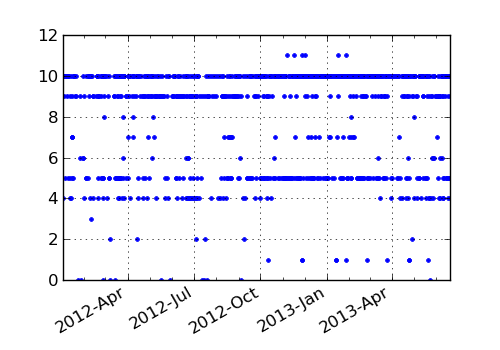
Events and obsids¶
With kadi it’s easy to find the obsid for a particular event using the
get_obsid() method of an event object that is
returned from a filter query. The following example asks for all maneuvers within the
range 2013:001:12:00:00 to 2013:002:12:00:00. It then prints the obsid for the first
matching maneuver, then prints the obsid for all matching maneuvers. Note that in this
case you do not use the final .table attribute as shown in the previous examples.
>>> manvrs = events.manvrs.filter('2013:001:12:00:00', '2013:002:12:00:00')
>>> print(manvrs[0].get_obsid())
15046
>>> for manvr in manvrs:
... print(manvr.start, 'Obsid :', manvr.get_obsid())
2013:001:16:38:45.535 Obsid : 15046
2013:001:21:16:45.361 Obsid : 15213
The converse of finding events that match an obsid is possible as well. In this case there may be zero, one or many matching events. In the following example we start by looking for all manuever events between 2013:100 and 2013:200 that have exactly two Kalman dwells:
>>> manvrs = events.manvrs.filter('2013:100', '2013:200', n_dwell__exact=2)
>>> print(manvrs)
<Manvr: start=2013:104:21:38:11.867 dur=1442 n_dwell=2 template=two_acq>
<Manvr: start=2013:142:12:43:01.918 dur=1763 n_dwell=2 template=three_acq>
<Manvr: start=2013:144:19:19:07.204 dur=1553 n_dwell=2 template=three_acq>
Now we get the obsid for the first matching maneuver and search for Kalman dwells with that obsid:
>>> print(manvrs[0].get_obsid())
15304
>>> print(events.dwells.filter(obsid=15304))
<Dwell: start=2013:104:22:04:05.255 dur=5795>
<Dwell: start=2013:104:23:41:44.155 dur=4290>
As expected this matches what comes from asking directly for the dwells associated
with the maneuver via the dwell_set attribute:
>>> print(manvrs[0].dwell_set.all())
<Dwell: start=2013:104:22:04:05.255 dur=5795>
<Dwell: start=2013:104:23:41:44.155 dur=4290>
Note
For most event types the event obsid (as returned by
get_obsid()) is defined as the obsid at the start
of the event. The exception is maneuver events, for which it makes most sense to use
the obsid at the end of the maneuver since that is the obsid for the corresponding
Kalman dwell(s), star catalog and OR / ER.
Getting help¶
There are a lot of event types in kadi and it’s not easy to remember everything.
Here we will make use of the IPython ? function to get help on objects.
Starting from the top, you can list the available event types with the following:
>>> from kadi import events
>>> events?
Type: module
String Form:<module 'kadi.events' from 'kadi/events/__init__.py'>
File: /data/baffin/tom/git/kadi/kadi/events/__init__.py
Docstring:
Access and manipulate events related to the Chandra X-ray Observatory
Available events are:
================= ==================================== ==============
Query name Description Event class
================= ==================================== ==============
caps CAP from iFOT database CAP
dark_cals ACA dark current calibration event DarkCal
dark_cal_replicas ACA dark current calibration replica DarkCalReplica
dsn_comms DSN comm period DsnComm
dumps Ground commanded momentum dump Dump
dwells Dwell in Kalman mode Dwell
eclipses Eclipse Eclipse
fa_moves SIM FA translation FaMove
grating_moves Grating movement (HETG or LETG) GratingMove
load_segments Load segment from iFOT database LoadSegment
ltt_bads LTT bad intervals LttBad
major_events Major event MajorEvent
manvrs Maneuver Manvr
manvr_seqs Maneuver sequence event ManvrSeq
normal_suns Normal sun mode event NormalSun
obsids Observation identifier Obsid
orbits Orbit Orbit
orbit_points Orbit point OrbitPoint
pass_plans Pass plan PassPlan
rad_zones Radiation zone RadZone
safe_suns Safe sun event SafeSun
scs107s SCS107 run Scs107
tsc_moves SIM TSC translation TscMove
================= ==================================== ==============
More help available at:
- Getting started
http://cxc.cfa.harvard.edu/mta/ASPECT/tool_doc/kadi/#getting-started
- Details (event definitions, filtering, intervals)
http://cxc.cfa.harvard.edu/mta/ASPECT/tool_doc/kadi/#details
Next you may want to learn about the specific fields that are available
for an event type. Use the same ? strategy here:
>>> events.orbits?
Type: EventQuery
String Form:<kadi.events.query.EventQuery object at 0x358f5d0>
File: /data/baffin/tom/git/kadi/kadi/events/query.py
Docstring:
Orbit
**Event definition**: single Chandra orbit starting from ascending node crossing
Full orbit, with dates corresponding to start (ORBIT ASCENDING NODE CROSSING), stop,
apogee, perigee, radzone start and radzone stop. Radzone is defined as the time
covering perigee when radmon is disabled by command. This corresponds to the planned
values and may differ from actual in the case of events that run SCS107 and
prematurely disable RADMON.
**Fields**
================== ========== ==================================================
Field Type Description
================== ========== ==================================================
start Char(21) Start time (orbit ascending node crossing)
stop Char(21) Stop time (next orbit ascending node crossing)
tstart Float Start time (orbit ascending node crossing)
tstop Float Stop time (next orbit ascending node crossing)
dur Float Orbit duration (sec)
orbit_num Integer Orbit number
perigee Char(21) Perigee time
apogee Char(21) Apogee time
t_perigee Float Perigee time (CXC sec)
start_radzone Char(21) Start time of rad zone
stop_radzone Char(21) Stop time of rad zone
dt_start_radzone Float Start time of rad zone relative to perigee (sec)
dt_stop_radzone Float Stop time of rad zone relative to perigee (sec)
================== ========== ==================================================
Class Docstring:
High-level interface for handling event queries.
This includes a few key methods:
- filter() : filter events matching criteria and return Django query set
- intervals(): return time intervals between event start/stop times
A key feature is that EventQuery objects can be combined with boolean
and, or, and not logic to generate composite EventQuery objects. From
there the intervals() output can be used to select or remove the intervals
from Ska.engarchive fetch datasets.
Finally, the EventQuery filter method has detailed help available to remind
you of syntax here:
>>> events.manvrs.filter?
Type: instancemethod
String Form:<bound method EventQuery.filter of <kadi.events.query.EventQuery object at 0x309e8d0>>
File: /data/baffin/tom/git/kadi/kadi/events/query.py
Definition: events.manvrs.filter(self, start=None, stop=None, obsid=None, subset=None, **kwargs)
Docstring:
Find events between ``start`` and ``stop``, or with the given ``obsid``, which
match the filter attributes in subsequent keyword argumentse. The matching events
are returned as a Django query set [1].
If ``start`` or ``stop`` are not supplied they default to the beginning / end of
available data. The optional ``subset`` arg must be a Python slice() object and
allows slicing of the filtered output.
This function allows for the powerful field lookups from the underlying
Django model implementation. A field lookup is similar to an SQL ``WHERE``
clause with the form ``<field_name>__<filter_type>=<value>`` (with a double
underscore between. For instance ``n_dwell__lte=1`` would be the same as
``SELECT ... WHERE n_dwell <= 1``. Common filter types are:
- ``exact`` (exact match), ``contains`` (contains string)
- ``startswith``, ``endswith`` (starts or ends with string)
- ``gt``, ``gte``, ``lt``, ``lte`` (comparisons)
- ``isnull`` (field value is missing, e.g. manvrs.aca_proc_act_start)
For the common case of testing equality (``exact``) there is a shortcut where
the ``__exact`` can be skipped, so for instance ``n_dwell=1`` selects
maneuver events with one dwell. The full list of field lookups is at [2].
Examples::
>>> from kadi import events
>>> events.manvrs.filter('2011:001', '2012:001', n_dwell=1, angle__gte=140)
>>> events.manvrs.filter('2011:001', '2012:001', subset=slice(None, 5)) # first 5
>>> events.manvrs.filter(obsid=14305)
[1]: https://docs.djangoproject.com/en/3.1/topics/db/queries/
[2]: https://docs.djangoproject.com/en/3.1/ref/models/querysets/#field-lookups
:param start: start time (DateTime compatible format)
:param stop: stop time (DateTime compatible format)
:param obsid: obsid for event
:param subset: subset of matching events that are output
:returns: Django query set with matching events
Use events to filter telemetry¶
Another common operation is using event intervals to filter telemetry data. A simple example is looking at EPHIN E1300 rates only outside of rad zone. A more complicated example is plotting OBC rate data only during “quiet” periods, which means during normal point mode with Kalman lock, at least 300 seconds away from any maneuvers, SIM motions, grating motions, and momentum dumps. With Kadi doing this sort of filtering is easy.
Here we show just the simple example above. First we plot the E1300 rates over a 30 day span, including rad zones:
>>> from Ska.engarchive import fetch
>>> plt.figure()
>>> e1300 = fetch.Msid("SCE1300", '2012:020', '2012:050')
>>> e1300_log = np.log10(e1300.vals.clip(10))
>>> plot_cxctime(e1300.times, e1300_log, '-b')
>>> ylabel('log10(E1300)')
>>> plt.grid()
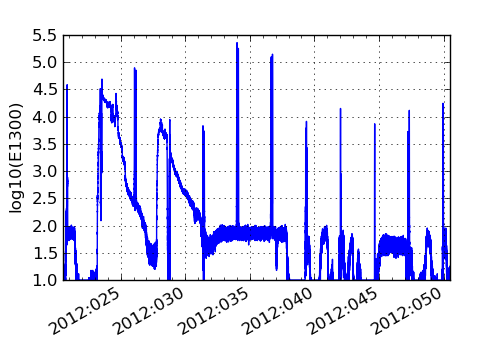
Now we remove the intervals corresponding to the radiation zone and overplot the filtered data in red:
>>> e1300.remove_intervals(events.rad_zones)
>>> e1300_log = np.log10(e1300.vals.clip(10))
>>> plot_cxctime(e1300.times, e1300_log, '-r')
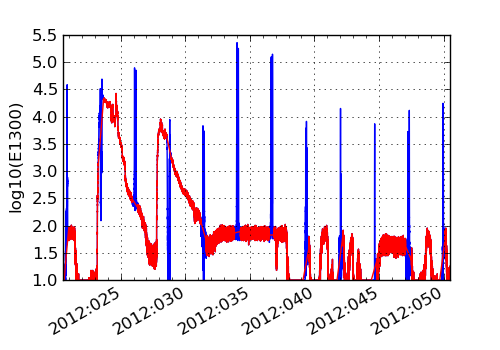
The converse operation of selecting intervals is also available:
>>> e1300.select_intervals(events.rad_zones)
Sometimes it is useful to select intervals in an MSID while retaining the
original full dataset. You can do this with the copy=True option, which
returns a brand new MSID object and leaves the original untouched:
>>> e1300 = fetch.Msid("SCE1300", '2012:020', '2012:050')
>>> e1300_rad_zones = e1300.select_intervals(events.rad_zones, copy=True)
More on intervals and padding¶
The event intervals themselves within a particular time range can be accessed as a list of
(start, stop) with the intervals() method:
>>> events.rad_zones.intervals('2012:020', '2012:030')
[('2012:020:14:56:33.713', '2012:020:23:42:31.713'),
('2012:023:06:15:15.541', '2012:023:16:15:33.248'),
('2012:025:21:22:22.506', '2012:026:08:10:20.506'),
('2012:028:13:22:04.533', '2012:028:22:20:02.533')]
Frequently you want to pad the intervals by a bit in each direction. For instance if you want stable spacecraft attitudes you would want to filter out events that disturb the attitude, namely SIM motions, grating motions, and momentum dumps. But the events cover just the exact interval of a motion or dump, and you’d like to chop out times for 5 or 10 minutes afterward. In addition, it’s usually a good idea to cut out a bit before just to be safe.
To pad the grating events out by 5 minutes in each direction, create a new EventQuery object like this:
>>> grating_moves = events.grating_moves(pad=300) # pad time in seconds
Positive values always make the interval bigger in each direction, so
a pad of 300 seconds makes the interval a total of 10 minutes longer (5 minutes
on each side). A pad of -300 seconds makes the interval start 5 minutes
later and end 5 minutes earlier.
You can be more precise and specify the padding at the event start and stop by providing two values, the start and stop pad time. Again, the convention is that positive padding is always making the interval longer in each direction.
>>> grating_moves = events.grating_moves(pad=(100, 300)) # pad time in seconds
To finish the example, we would define similar padded events for the SIM moves and dumps:
>>> tsc_moves = events.tsc_moves(pad=(100, 300))
>>> dumps = events.dumps(pad=(100, 300))
You can examine or set the padding using the interval_pad attribute:
>>> dumps.interval_pad
<Pad start=100.0 stop=300.0 seconds>
>>> dumps.interval_pad = 500
>>> dumps.interval_pad
<Pad start=500.0 stop=500.0 seconds>
You can also set the interval pad for an event type directly. This method is discouraged, but shown below for reference since this used to be the accepted method:
>>> events.grating_moves.interval_pad = -100
Boolean combinations¶
The real power of intervals is that they can be combined with boolean expressions and can be padded on either end to make it easy to create complex time filters. Using the results in the previous section, we can create a composite event which is when there is a grating move OR a momentum dump OR a SIM (TSC) move:
>>> disturbances = grating_moves | dumps | tsc_moves
The following example selects all Kalman mode dwells, but removes times that could be affected by a SIM TSC move or a momentum dump.
>>> dwells = events.dwells(pad=-100)
>>> good_times = dwells & ~disturbances # Dwells and NOT disturbances
You can examine the composite good_times event query and see how it is constructed of
boolean combinations of the underlying base event query objects:
>>> good_times
(<EventQuery: Dwell pad=-100.0> AND NOT ((<EventQuery: GratingMove pad=(100.0, 300.0)>
OR <EventQuery: Dump pad=(100.0, 300.0)>) OR <EventQuery: TscMove pad=(100.0, 300.0)>))
Finally you can you this composite event query to define times for selecting telemetry of interest:
>>> dat = fetch.Msid('aoattqt1', '2012:001', '2012:002')
>>> dat.plot()
>>> dat_good = dat.select_intervals(good_times, copy=True)
>>> dat_good.plot('.r')
>>> plt.grid()
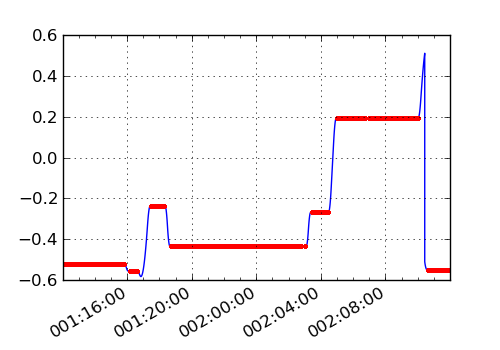
Filtering the interval events¶
The examples shown above share the feature that the selected intervals were defined using all of the events for a particular type. However, it is also possible to select only a subset of the available events based on other filter criteria. For example, if you wanted to examine telemetry during HETG insertions. This would be a snap with the following, which defines a new event query which is the subset of HETG insertion grating moves:
>>> hetg_insert = events.grating_moves(pad=50, grating='HETG', direction='INSR')
This new event query object can be used just like the original events.grating_moves
except that now it only has HETG insertion events.
>>> events.grating_moves
<EventQuery: GratingMove pad=0.0>
>>> hetg_insert
<EventQuery: GratingMove pad=0.0 direction='INSR' grating='HETG'>
To overplot the grating angle as a function of time since the grating move start you might do:
>>> intervals = hetg_insert.intervals('2010:001', '2010:030')
>>> intervals
>>> print intervals # This is a list of (start, stop) pairs
[('2010:002:15:25:39.725', '2010:002:15:28:15.013'),
('2010:004:09:41:29.708', '2010:004:09:44:04.996'),
...
('2010:018:13:36:14.745', '2010:018:13:38:50.033'),
('2010:021:04:47:00.207', '2010:021:04:49:35.494')]
>>> for start, stop in intervals:
... dat = fetch.Msid('4hposaro', start, stop)
... plot(dat.times - dat.times[0], dat.vals)
LTT bad times¶
Another example of practical interest is using the LTT bad times event to remove bad times for long-term trending plots by MSID. Before explaining more about what is going on, here is an example of filtering out LTT bad times (for the impatient):
>>> dat = fetch.Msid('AIRU2BT', '2011:001', '2013:001', stat='daily')
>>> dat_good = dat.remove_intervals(events.ltt_bads(msid='AIRU2BT'), copy=True)
>>> dat.plot('r', label='All')
>>> dat_good.plot(label='Good')
>>> plt.ylim(96, 103)
>>> plt.grid()
>>> plt.legend(fontsize='small')
>>> plt.title('AIRU2BT')
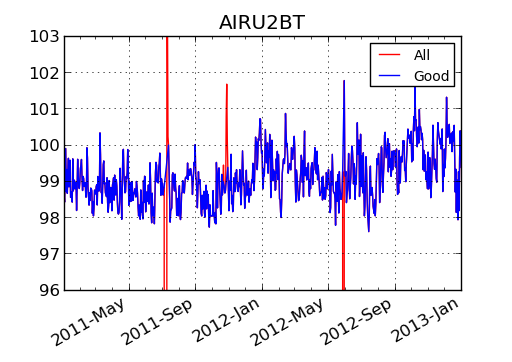
Now let’s look more closely at the LTT bad times events, which are derived from a
FOT-supplied file that has the dates when particular trending items (the msid column)
are bad for some reason:
>>> print events.ltt_bads.filter('2000:001', '2001:001').table
start stop tstart tstop dur msid flag
--------------------- --------------------- ------------ ------------ ------- --------------- ----
2000:001:00:00:00.000 2000:002:00:00:00.000 63072064.184 63158464.184 86400.0 PITCH_STAB_PERF J
2000:001:00:00:00.000 2000:002:00:00:00.000 63072064.184 63158464.184 86400.0 YAW_STAB_PERF J
2000:004:00:00:00.000 2000:005:00:00:00.000 63331264.184 63417664.184 86400.0 GCM_TSCACC 1
... ... ... ... ... ... ...
2000:358:00:00:00.000 2000:359:00:00:00.000 93916864.184 94003264.184 86400.0 3SDM15V 1
2000:358:00:00:00.000 2000:359:00:00:00.000 93916864.184 94003264.184 86400.0 3SDP5V 1
2000:366:00:00:00.000 2001:001:00:00:00.000 94608064.184 94694464.184 86400.0 3SDM15V 1
Some of the msid values correspond to like-named MSIDs in the engineering archive, but
many (including all those shown here) do not. You can find the non-matches with:
>>> print(sorted(set(x.msid for x in events.ltt_bads.filter('1999:001'))
if not (x.msid in fetch.content or 'DP_' + x.msid in fetch.content)))
[u'*', u'3SDAGV', u'3SDFATSV', u'3SDM15V', u'3SDP15V', u'3SDP5V', u'3SDTSTSV', u'5EHSE300', u'ABIASZ',
...
u'ROLL_BIAS_DIFF', u'SAMYTEMDEL', u'SAPYTEMDEL', u'TFCAG', u'TFCDG', u'VECANGLE_DIFF',
u'YAW_BIAS_DIFF', u'YAW_CTRL', u'YAW_STAB', u'YAW_STAB_PERF']
There is a special msid value of '*' which corresponds to times that are bad for ALL
MSIDs. The bad intervals with msid == '*' are always included in query results:
>>> events.ltt_bads(msid='AACCCDPT').all()
<LttBad: start=1999:270:00:00:00.000 msid=* flag=*>
<LttBad: start=1999:291:00:00:00.000 msid=* flag=*>
<LttBad: start=1999:295:00:00:00.000 msid=* flag=*>
...
<LttBad: start=2011:190:00:00:00.000 msid=* flag=*>
<LttBad: start=2011:191:00:00:00.000 msid=AACCCDPT flag=A>
<LttBad: start=2011:192:00:00:00.000 msid=AACCCDPT flag=A>
...
<LttBad: start=2011:302:00:00:00.000 msid=AACCCDPT flag=A>
<LttBad: start=2012:150:00:00:00.000 msid=* flag=*>
<LttBad: start=2012:151:00:00:00.000 msid=* flag=*>
Selecting overlapping events¶
Frequently you are interested in getting events based on overlap with other events. Examples include:
Select maneuver events either inside or outside the radiation zone.
Select SIM moves that occur during a maneuver.
Select maneuvers that have a SIM or Grating move.
This is possible using the select_overlapping()
method of a QuerySet object. A QuerySet is the object that gets returned when you use
the filter() or all()
methods.
This is all easiest to see by example. Start by getting a subset of maneuvers that occurred between 2001:001:00:00:00 and 2001:003:00:00:00:
>>> manvrs = events.manvrs.filter('2001:001:00:00:00', '2001:003:00:00:00')
>>> manvrs
<Manvr: start=2001:001:07:48:35.843 dur=2073 n_dwell=2 template=nman_dwell>
<Manvr: start=2001:002:05:20:14.046 dur=1184 n_dwell=1 template=normal>
<Manvr: start=2001:002:08:53:23.997 dur=241 n_dwell=1 template=normal>
<Manvr: start=2001:002:14:55:24.773 dur=240 n_dwell=1 template=normal>
<Manvr: start=2001:002:20:50:34.523 dur=1185 n_dwell=1 template=normal>
>>> type(manvrs)
<class 'kadi.events.models.QuerySet'>
Now let’s find which of those had at least some portion inside the rad zone:
>>> manvrs.select_overlapping(events.rad_zones)
[<Manvr: start=2001:002:05:20:14.046 dur=1184 n_dwell=1 template=normal>,
<Manvr: start=2001:002:08:53:23.997 dur=241 n_dwell=1 template=normal>,
<Manvr: start=2001:002:14:55:24.773 dur=240 n_dwell=1 template=normal>]
This makes sense if you look at the rad zone times near then:
>>> events.rad_zones.filter('2001:001:00:00:00', '2001:003:00:00:00')
<RadZone: 194 2001:002:05:15:03 2001:002:20:50:23 dur=56.1 ksec>
We can turn it around and ask which maneuvers had some part outside of the rad zone,
remembering the boolean expression logic that is possible. In fact any composite
QueryEvent expression can be used as the argument:
>>> manvrs.select_overlapping(~events.rad_zones)
[<Manvr: start=2001:001:07:48:35.843 dur=2073 n_dwell=2 template=nman_dwell>,
<Manvr: start=2001:002:20:50:34.523 dur=1185 n_dwell=1 template=normal>]
One subtlety here is that the original manvrs object is a QuerySet while the result
of select_overlapping is a list of event objects. A QuerySet is more powerful
because you could apply further filtering and so on, while the list is just a regular
Python list. In practice this is not a real limitation.
Now on to the example of finding SIM moves that occur during a maneuver:
>>> tsc_moves = events.tsc_moves.filter('2010:191', '2010:192')
>>> tsc_moves
<TscMove: start=2010:191:18:34:00.978 dur=262 start_3tscpos=75623 stop_3tscpos=-99616>
<TscMove: start=2010:192:01:42:36.179 dur=230 start_3tscpos=-99616 stop_3tscpos=75623>
<TscMove: start=2010:192:03:27:33.779 dur=33 start_3tscpos=75623 stop_3tscpos=92903>
>>> tsc_moves.select_overlapping(events.manvrs)
[<TscMove: start=2010:191:18:34:00.978 dur=262 start_3tscpos=75623 stop_3tscpos=-99616>,
<TscMove: start=2010:192:01:42:36.179 dur=230 start_3tscpos=-99616 stop_3tscpos=75623>,
<TscMove: start=2010:192:03:27:33.779 dur=33 start_3tscpos=75623 stop_3tscpos=92903>]
All of these moves overlapped with a maneuver, but what if we want the moves that occurred
entirely within a maneuver. To do this set the allow_partial=False to insist on
complete overlaps:
>>> tsc_moves.select_overlapping(events.manvrs, allow_partial=False)
[<TscMove: start=2010:192:01:42:36.179 dur=230 start_3tscpos=-99616 stop_3tscpos=75623>,
<TscMove: start=2010:192:03:27:33.779 dur=33 start_3tscpos=75623 stop_3tscpos=92903>]
This makes sense if you look at the maneuvers in that time interval. The first of the
three SIM moves started before the maneuver at 191:18:36:37 but lasted about two minutes
into the maneuver.
>>> events.manvrs.filter('2010:191', '2010:192')
<Manvr: start=2010:191:12:39:40.939 dur=240 n_dwell=1 template=normal>
<Manvr: start=2010:191:18:36:37.290 dur=241 n_dwell=1 template=normal>
<Manvr: start=2010:192:01:41:47.492 dur=1020 n_dwell=1 template=normal>
<Manvr: start=2010:192:03:26:36.892 dur=2869 n_dwell=1 template=normal>
To find every SIM-Z move in 2011 that didn’t overlap at all with a maneuver you would do:
>>> tsc_moves = events.tsc_moves.filter('2011:001', '2012:001')
>>> tsc_moves.select_overlapping(~events.manvrs, allow_partial=False)
[<TscMove: start=2011:158:15:24:01.657 dur=262 start_3tscpos=92903 stop_3tscpos=-99616>,
<TscMove: start=2011:216:07:03:21.245 dur=230 start_3tscpos=75623 stop_3tscpos=-99616>,
<TscMove: start=2011:297:18:28:57.614 dur=262 start_3tscpos=92903 stop_3tscpos=-99616>,
<TscMove: start=2011:299:05:05:28.208 dur=230 start_3tscpos=75623 stop_3tscpos=-99616>]
Details¶
The advanced usage section is incomplete, however examples of advanced usage are demonstrated in thie Kadi demo IPython notebook. Please refer to this notebook and download and run it.
Event definitions¶
Event class |
Description |
Query name |
|---|---|---|
|
||
|
||
|
||
|
||
|
||
|
||
|
||
|
||
|
||
|
||
|
||
|
||
|
||
|
||
|
||
|
||
|
||
|
||
|
||
|
||
|
||
|
||
|
Event filtering¶
The EventQuery filter()
method allows you to find events between start and stop, or with the given
obsid, which match the filter attributes in subsequent keyword arguments. The
matching events are returned as a Django query set [1].
If start or stop are not supplied they default to the beginning / end of
available data. The optional subset arg must be a Python slice() object and
allows slicing of the filtered output.
This method allows for the use of Django field lookups from the
underlying Django model implementation. A field lookup is similar to an SQL WHERE
clause with the form <field_name>__<filter_type>=<value> (with a double underscore
between). For instance n_dwell__lte=1 would be the same as SELECT ... WHERE n_dwell
<= 1. Common filter types are:
exact(exact match),contains(contains string)startswith,endswith(starts or ends with string)gt,gte,lt,lte(comparisons)isnull(field value is missing, e.g. manvrs.aca_proc_act_start)
For the common case of testing equality (exact) there is a shortcut where
the __exact can be skipped, so for instance n_dwell=1 selects
maneuver events with one dwell. For a full list of field lookups see the general
Django documentation on Making queries
Examples:
>>> from kadi import events
>>> events.manvrs.filter('2011:001', '2012:001', n_dwell=1, angle__gte=140)
>>> events.manvrs.filter('2011:001', '2012:001')[:5] # first 5
>>> events.manvrs.filter(obsid=14305) # Manveuver(s) where obsid=14305 at start
To get all of the events use the all() method:
>>> events.normal_suns.all()
<NormalSun: start=2000:027:13:33:38.872 dur=1020>
<NormalSun: start=2000:049:03:23:08.544 dur=126872>
...
<NormalSun: start=2011:299:05:09:02.945 dur=81773>
<NormalSun: start=2012:151:12:33:36.285 dur=48711>
Advanced filtering¶
The result of a filter() query is a Django
QuerySet object. From this starting point you can chain additional queries
or take advantage of any of the QuerySet functionality described in
Making queries.
For example if you wanted to find all maneuvers in 2011-Jan that were not “normal” and did not have an intermediate attitude, you could do:
>>> manvrs_2011 = events.manvrs.filter('2011-01-01T00:00:00', '2012-01-01T00:00:00')
>>> manvrs_2011.exclude(template='normal').exclude(template='interm_att')
<Manvr: start=2011:111:11:09:03.933 dur=1011 n_dwell=1 template=two_acq>
<Manvr: start=2011:112:06:22:42.186 dur=1116 n_dwell=1 template=two_acq>
...
<Manvr: start=2011:296:21:46:41.147 dur=1934 n_dwell=2 template=three_acq>
<Manvr: start=2011:298:22:07:37.432 dur=492 n_dwell=3 template=unknown>
To go really crazy and allow for even more complex queries, like those requiring OR
logic, you can use Django Q objects.
